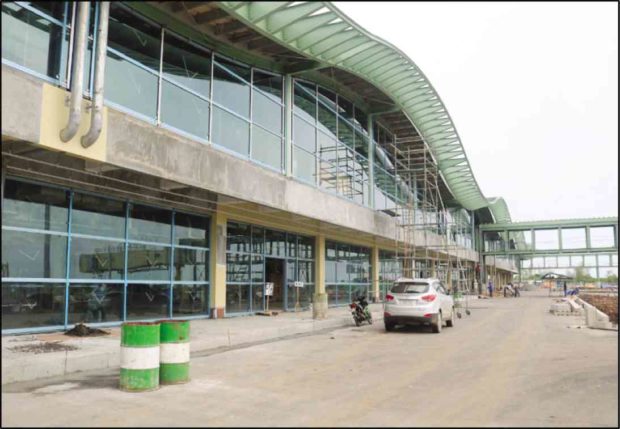
BOHOL PROGRESS The operation of the Bohol Panglao International Airport is expected to boost Bohol’s economy. EDCOM/DOTR PHOTO
TAGBILARAN CITY—After three decades, the once “airport in the sand” is now an inch closer to firmer ground.
The P7.8-billion Panglao Island International Airport, renamed Bohol Panglao International Airport, is scheduled to be operational this year and expected to spur economic development and local employment.
It will replace the small Tagbilaran Airport, the current Bohol gateway and the 11th busiest airport in the Philippines.
As of June 30, the bigger airport was about 90.14-percent complete, according to the Department of Transportation (DOTr).
Once completed, the facility surrounded by beautiful marine areas will be the country’s first eco-airport to be dubbed “Green Gateway to the World.”
The project pays special attention to environmental protection as it constructs a green airport using Japanese technology.
According to the DOTr, the airport features “environmentally friendly” and “sustainable” structures, including solar panels on the passenger terminal building. Solar power will supply one-third of the facility’s electricity needs.
2M passengers
On its opening year, 2 million passengers are expected to go through the terminal, more than twice the 800,000 handled by the province’s lone airport every year.
The airport project’s main contractor, Chiyoda Mitsubishi Joint Venture, was supposed to turn over the passenger terminal, runway control tower and other key structures by Aug. 15, but the event was indefinitely postponed, DOTr project manager Edgardo Mangalili said in an earlier interview.
The facility may be used by then, but the Civil Aviation Authority of the Philippines (CAAP) has yet to decide when commercial operations will start officially, Mangalili said.
The CAAP will oversee the airport until a private company takes over the operations and maintenance.
There are still no cargo terminals, but Mangalili said airline companies would put up the buildings.
Game changer
Bohol officials consider the new airport an economic landmark and a game changer for the province’s progress.
“An airport acts as a driver of economic growth and development across all sectors. This will expand the production possibility frontiers of Bohol, the region and the country,” Gov. Edgar Chatto said.
The benefits of an international airport far outweigh its perceived challenges, Chatto said.
GREEN GATEWAY The Bohol Panglao International Airport
is considered the Philippines’ “Green Gateway to the World.” —EDCOM/DOTR
It serves as a backup facility to Mactan-Cebu International Airport, especially if flights need to be diverted during emergency.
As another entry point to the country, it helps ease airport operations in Manila and other cities while boosting Bohol’s connectivity to other destinations in the country and abroad.
Chatto said the new airport would attract more investments, particularly those related to tourism, and generate local jobs and livelihood.
“If a farming family is able to sell their produce to a hotel or restaurant, is that not a benefit to ordinary Boholanos? If the members of Tubigon Loomweavers Cooperative are able to sell their products to foreign buyers, is that not good for the local economy? If our drivers, boatmen, tour guides, room service staff, masseurs and reflexologists are able to secure sustained employment, is that not a benefit to ordinary Boholanos?” he asked.
Chatto described tourism as “one of the world’s largest and most resilient industries with 10 percent of global workforce.”
Multiplier effect
“Its multiplier effect on various industries stimulates the local economy, which results in reduction of poverty,” he added.
Having an international airport has been the dream of five Bohol governors—Contancio Torralba, David Tirol, Rene Relampagos, Erico Aumentado and Chatto—and six presidents—Corazon Aquino, Fidel Ramos, Joseph Estrada, Gloria Macapagal-Arroyo, Benigno Aquino III and Rodrigo Duterte.
The project idea started in the late 1980s, during Torralba’s term, but public interest somehow waned. It was revived during the time of Aumentado that drew the support of Arroyo though it had only a P1-billion budget.
On May 8, 2008, Arroyo laid the time capsule for the P4.2-billion airport in Panglao. The project went in limbo after the event.
It was only during the term of Aquino that it finally moved.
On Sept. 4, 2012, the National Economic and Development Authority gave the green light for the airport’s construction in a resolution.
Funding would come from the Official Development Assistance instead of the public-private partnership, a government program for infrastructure-building that allows the private sector to participate in any of the schemes authorized under the build-operate-transfer law.
On March 27, 2013, the Japan International Cooperation Agency signed an agreement with the Philippines to build Panglao Island International Airport at 10.78 billion yen under the project name New Bohol Airport Construction and Sustainable Environment Protection Project.
Construction began in June 2015.
When then President Aquino visited the project site on March 4, 2016, he said he was looking forward to coming back to Bohol no longer as the Chief Executive but as a tourist. He might just be able to do that soon.